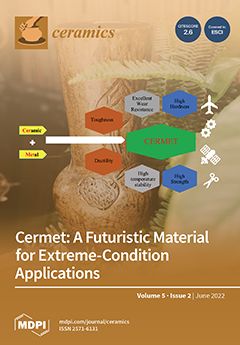Open AccessArticle
Investigation of the Microstructure of Fine-Grained YPO4:Gd Ceramics with Xenotime Structure after Xe Irradiation
by
Dmitriy A. Mikhaylov, Ekaterina A. Potanina, Aleksey V. Nokhrin, Albina I. Orlova, Pavel A. Yunin, Nikita V. Sakharov, Maksim S. Boldin, Oleg A. Belkin, Vladimir A. Skuratov, Askar T. Issatov, Vladimir N. Chuvil’deev and Nataliya Y. Tabachkova
Cited by 8 | Viewed by 2172
Abstract
This paper reports on the preparation of xenotime-structured ceramics using the Spark Plasma Sintering (SPS) method. Y
0.95Gd
0.05PO
4 (YPO
4:Gd) phosphates were obtained using the sol-gel method. The synthesized powders were nanodispersed and were agglomerated (the agglomerates sizes
[...] Read more.
This paper reports on the preparation of xenotime-structured ceramics using the Spark Plasma Sintering (SPS) method. Y
0.95Gd
0.05PO
4 (YPO
4:Gd) phosphates were obtained using the sol-gel method. The synthesized powders were nanodispersed and were agglomerated (the agglomerates sizes were 10–50 µm). The ceramics had a fine-grained microstructure and a high relative density (98.67 ± 0.18%). The total time of the SPS process was approximately 18 min. The sintered high-density YPO
4:Gd ceramics with a xenotime structure were irradiated with
132Xe
+26 ions with 167 MeV of energy and fluences in the range of 1 × 10
12–3 × 10
13 cm
−2. Complete amorphization was not achieved even at the maximum fluence. The calculated value of the critical fluence was (9.2 ± 0.1) × 10
14 cm
−2. According to the results of grazing incidence X-ray diffraction (GIXRD), the volume fraction of the amorphous structure increased from 20 to 70% with increasing fluence from 1 × 10
12 up to 3 × 10
13 cm
−2. The intensity of the 200 YPO
4:Gd XRD peak reached ~80% of the initial intensity after recovery annealing (700 °C, 18 h).
Full article
►▼
Show Figures





